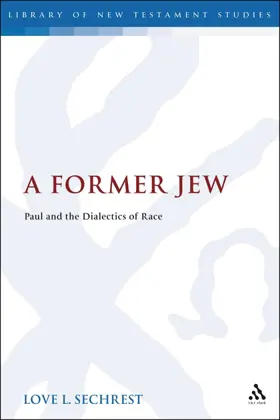

A Former Jew: Paul and the dialectics of race
in Library of New Testament Studies
Pages
288
Publisher
T&T Clark
Published
1/5/2010
ISBN-13
9780567462749
Sechrest describes Pauline Christianity as a nascent ancient racial group, drawing on a Jewish understanding of race in Second Temple Judaism.
With analysis of nearly five thousand Jewish and non-Jewish passages about identity from around the turn of the era, the models presented describe ancient Greek and Jewish ethnic and racial identity. Further, these models become resources for examining the racial character of Paul's self-identity and the continuities and discontinuities between the three races in his social world: Jews, Gentiles, and Christians.
Using historical and literary methods of exegesis for passages in the Pauline corpus, Sechrest describes Paul as someone who was born a Jew, but who later saw himself as a member of a different race. Analyzing Christian identity in Galatians in terms of membership criteria, membership indicia, and inter-group dynamics, a final section of the book contrasts the portrait of Paul that emerges from this study with those in Daniel Boyarin's A Radical Jew: Paul and the Politics of Identity and Brad Braxton's No Longer Slaves: Galatians and African American Experience. This section engages all three of these descriptions of community and identity, and illuminates the problems and opportunities contained in a modern appropriation of a racial construction of Christian identity.
With analysis of nearly five thousand Jewish and non-Jewish passages about identity from around the turn of the era, the models presented describe ancient Greek and Jewish ethnic and racial identity. Further, these models become resources for examining the racial character of Paul's self-identity and the continuities and discontinuities between the three races in his social world: Jews, Gentiles, and Christians.
Using historical and literary methods of exegesis for passages in the Pauline corpus, Sechrest describes Paul as someone who was born a Jew, but who later saw himself as a member of a different race. Analyzing Christian identity in Galatians in terms of membership criteria, membership indicia, and inter-group dynamics, a final section of the book contrasts the portrait of Paul that emerges from this study with those in Daniel Boyarin's A Radical Jew: Paul and the Politics of Identity and Brad Braxton's No Longer Slaves: Galatians and African American Experience. This section engages all three of these descriptions of community and identity, and illuminates the problems and opportunities contained in a modern appropriation of a racial construction of Christian identity.
- Table of Contents
- Introduction
- Chapter 1: "The Third Race" and Pauline Studies
- A. Race, Ethnicity, and NT Scholarship
- B. Studying Race and Ethnicity
- Part 1 - Models of Racial and Ethnic Identity
- Chapter 2: Race and Ethnicity in Modernity
- A. The Modern Idea of Race
- B. Ethnicity in Late 20th Century Scholarship
- C. Models of Race and Ethnicity
- D. Focal Images
- Chapter 3: Race and Ethnicity in Antiquity
- A. Etymology of Race and Ethnicity
- B. Race and Ethnicity in non-Jewish, Jewish, and Christian Authors
- C. Greek and Jewish Perspectives on Race and Ethnicity
- D. Ethnicity and Race: Ancient and Modern Perspectives
- Chapter 2: Race and Ethnicity in Modernity
- Part 2 - The Racial Character of Pauline Christianity
- Chapter 4: Paul's Self-Identity and Relational Matrix
- A. Community and Kinship in Paul
- B. Paul's Self-Identity and Group Affiliation
- C. A Former Jew
- Chapter 5: The Dialectics of Christian Racial Identity
- A. Eschatological Criteria
- B. Eschatological Indicia
- C. Eschatological Relationships
- D. Continuity and Discontinuity in Paul
- Chapter 4: Paul's Self-Identity and Relational Matrix
- Conclusion
- Chapter 6: Scandal and Opportunity in Racial Christianity
- A. Paul and Daniel Boyarin's A Radical Jew
- B. Paul and Brad Braxton's No Longer Slaves
- Chapter 6: Scandal and Opportunity in Racial Christianity